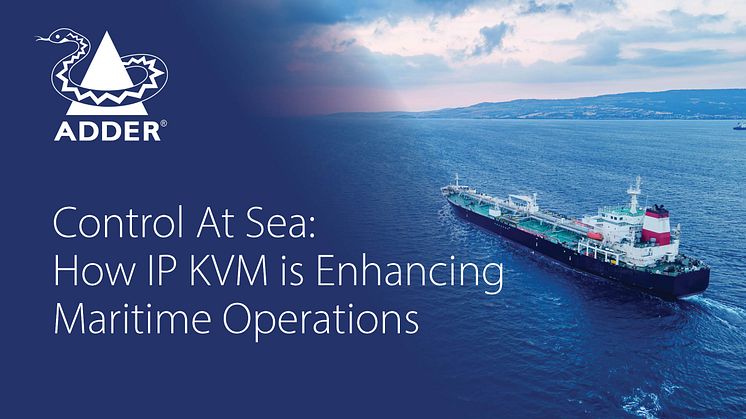
Blog post -
Control At Sea: How IP KVM Is Enhancing Maritime Operations
From research vessels to offshore platforms, the maritime industry operates under extreme conditions where system reliability and efficient control are non-negotiable. As operations become more data-driven and distributed, the ability to manage multiple systems from a single workstation is a necessity.
Whether in research exploration or commercial shipping, the control room is at the core of any operation. To keep pace with evolving demands, maritime organisations are rethinking how they design their control systems, improve workflows and operational efficiency on board the vessel. A key component to this is IP based KVM (keyboard, visual, mouse) – a technology that allows instant, centralised access to multiple systems without compromising on performance or uptime.
Why Control Infrastructure is Becoming a Strategic Priority
Maritime professionals today are dealing with more than just navigational data. From onboard diagnostics to real-time video feeds, surveillance systems and environmental monitoring tools, the modern vessel becomes a floating data centre.
In this context, simplifying system access and reducing operator workload becomes essential. The traditional approach of multiple keyboards, monitors and a tangle of cables is inefficient and difficult to scales. This is where IP KVM comes in, offering a smarter way to control systems from a centralised interface. IP KVM technology is trusted by maritime professionals around the world to reduce response times and improve operational uptime.
Design Priorities for a Modern Maritime Control Room
In a control room at sea, operators often need to move fluidly between navigation software, communication systems, monitoring tools and more – all running on different machines. A single error or delay in switching between systems can have major implications.
Advanced desktop switching solutions now support multiple connected systems, allowing users to control everything with a single keyboard and mouse. Additionally, technologies like Adder’s Free Flow cursor navigation eliminate the need to manually toggle inputs. The result is a smoother, faster workflow that helps crews respond quickly, even in mission-critical scenarios.
Building an effective maritime control system requires careful attention to both space and resilience. Whether it’s on the bridge of a research vessel or in a tightly packed equipment room, every inch of space matters. When the vessel operates 24/7 for weeks at sea, downtime isn’t just inconvenient, but it’s expensive too.
To meet these challenges, next generation KVM systems are being designed around key principles:
- USB True Emulation: Instant switching without disrupting peripheral behaviour
- Redundant Power Inputs: Ensuring uptime even if a power source fails
- Keep-Alive Functions: Preventing target systems from sleeping during inactivity
- Third-Party Integration: Supporting external control via API or serial inputs
- Streamlined Setup: Reducing cable clutter and simplifying operator training
"Maritime control rooms don’t just need wider access; they need smarter access. That’s why we focused on intuitive workflows, instant switching and seamless cursor navigation in addition to a resilient and scalable architecture. It's not just about switching video and peripherals; it's about safely and reliably empowering critical decisions in real time." Product Manager, Adder Technology
Engineered for Demanding Environments
With vessels such as the Tom Crean and Celtic Explorer, P&O needed a solution that offered redundancy, simplicity, and resilience. Using IP KVM technology, their crews gained uninterrupted control during multi-week operations - read their story here.
“IP KVM offers the expandability we require. We have the redundancy we require with ADDERLink® Infinity Managers. The vessel operates 24/7 for 3–4-week blocks. Down time is expensive, so reliability and redundancy are key requirements.” Instrumentation & IT Manager, P&O Maritime Services
The Jan de Nul marine construction company is another example of a complex install. With growing challenges in expanding traditional KVM systems across their diverse marine engineering and construction fleet, it prompted them to explore IP KVM, which has now improved system flexibility, workspace ergonomics and increased productivity – read their story here.
“By using the ADDERLink® XDIP system onboard, we did not only simplify our spare part strategy, we also chose a future proof technology that enables us to scale with great flexibility in our dynamic fleet which keeps expanding” Senior Engineer, Survey Department, Jan de Nul Group
The Future of Control at Sea
As maritime operations continue to evolve with remote diagnostics, real-time analytics, and enhanced decision-making, the importance of responsive, scalable control systems will only grow.
IP KVM is more than a convenience, it is an enabler of smarter, safer, and more efficient maritime operations. By decoupling the user experience from physical hardware constraints, it gives crews the flexibility to adapt faster, work more comfortably, and maintain situational awareness, no matter the complexity or conditions out at sea.
For maritime operators planning their next generation of vessels, investing in the right control infrastructure can future-proof operations for years to come.
